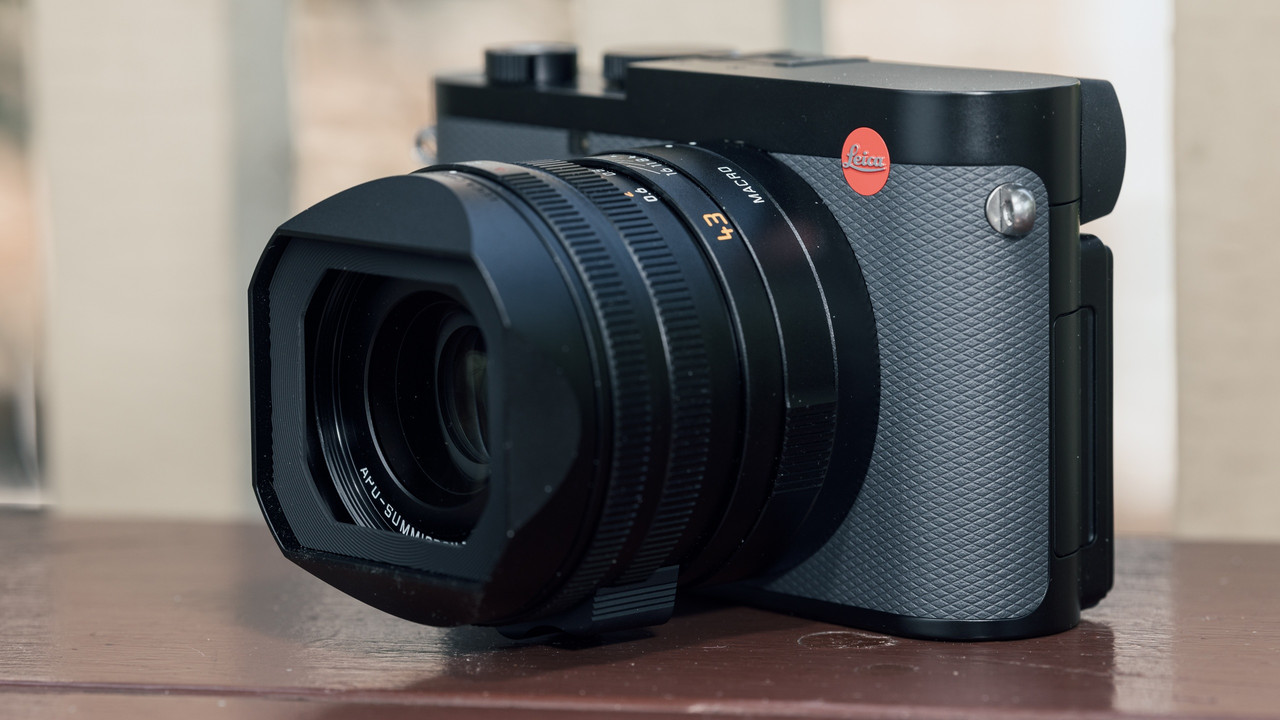Introduction
The Leica Q3 43 is a premium fixed lens compact camera which marries a 60 megapixel 35mm full-frame CMOS sensor with an image-stabilized Leica Summilux 43mm f/2 prime lens.
Optically, this brand new lens is constructed of 11 lenses in 8 groups containing 7 aspherical lens components and it includes a Macro option that enables it to focus as close as 26.5cms / 10.4".
This camera employs the same BSI (BackSide Illuminated) CMOS sensor as the M11 rangefinder, which utilises a specially built dual-layer UV/IR cut-off filter.
Key features of the Q3 43 include an extended sensitivity range of ISO 50-100,000, the latest-generation Maestro IV image processor, 8K/30p, 4K/60p and 1080/120p video recording, a hybrid AF system with an intelligent subject recognition technology, and continuous shooting up to 15fps.
This new model for 2024 also provides 350 shot battery life, USB-C connection, a 5.76m-dot OLED EVF and a tilting 1.84m-dot touchscreen LCD screen.
Ease of Use

There is just really one important difference between the new Leica Q3 43 and the original Q3 from mid-2023, and that's the lens.
Whereas the Q3 features a wide-angle 28mm f/1.7 lens, as its name implies the Q3 43 has a unique 43mm optic that delivers a more conventional view of the world.
This is because on a 35mm full-frame sensor, 43mm is the length of the diagonal measurement, hence the 43mm focal length exactly fits the sensor and thereby more nearly resembles human eyesight than either a 50mm or 35mm lens.
Choosing between the old Q3 and the new Q3 43 is simply a simple option between the angle of view - 28mm "wide" and 43mm "normal" - since in practically every other way the two cameras are similar.
Side by side, the Q3 43 has a mid-grey leatherette coating on the front of its body, rather than the black leatherette of the original - I like the more subtle approach of the Q3.
The other visible distinctions to help tell them apart are the "43" moniker that's etched on the lens barrel instead of "28" on the Q3 and the "Leica Q3 43" name that's engraved on the hotshoe rather than "Leica Q3" on the original.
Despite featuring a longer lens, the two cameras are even virtually identical in size and weight - 130 x 80.3 x 97.6mm and 688g for the Q3 43 versus 130 x 80,3 x 92,6mm and 658g for the Q3 - so there's no penalty here for choosing the Q3 43 other than the longer, heavier lens means that it tilts forwards slightly on a level surface (which is more annoying for taking product shots of the camera rather than actually using it).
The new 43mm lens has a slightly slower maximum aperture than the Q3's 28mm optic - f/2 vs f/1.7 - but in the real world this has a minor effect, with the greater focal length helping to compensate in terms of bokeh effects.
There's also a difference in the Macro modes of each camera, with the Q3 43 giving a minimum focusing distance of 26.5cms / 10.4" versus 17cms / 6.7" on the original, although again the greater focal length helps to counteract this.
Read Also: Setting Recommendations for the Fuji X-T3
Image Quality

All of the example photographs in this review were taken on the 60 megapixel Large setting, which yields an average image size of roughly 30Mb for JPEGs and 85Mb for RAW files.
The Leica Q3 43 captured still photographs with great quality during the evaluation time.
This camera provides noise-free JPEG photographs at ISO 50 up to ISO 3200, with slight noise occurring at ISO 6400. The quicker settings of ISO 12500 through to 25000 are still useable, however we'd advocate avoiding both ISO 50000 and 100000 if at all feasible. The related Raw files have far fewer noticeable color artifacts but are noticeably less crisp than their JPEG equivalents.
The night photograph was quite excellent, with the highest shutter speed of 60 minutes allowing you to catch enough light in any circumstance, and the Film Styles, although restricted in quantity and customisability, enable you to rapidly modify the look of JPEG files.
Noise
ISO sensitivity may be changed between ISO 64 and ISO 100,000 in full-stop increments. Here are some 100% crops which demonstrate the noise levels for each ISO setting, with JPEG on the left and RAW on the right.
Focal Range
The Leica Q3 43's lens gives a focal length of 43mm in 35mm terms, as seen below.
Macro
The Leica Q3 43 includes a Macro option that lets you to concentrate on a subject that is 26.5cms / 10.4" distant from the camera.
Night
The Leica Q3 43's maximum shutter speed is 60 seconds in the Manual mode, which is wonderful news if you're genuinely interested in night photography.
Intelligent Dynamic Range (iDR)
The Intelligent Dynamic Range feature offers an optimization of the darkest portions in a JPEG image, with object details becoming much apparent. There are three distinct possible strengths, Low, Standard and High, with Auto and Off options.
Film Styles
Leica's Film Styles are predefined combinations of varied sharpness, contrast and saturation settings, for JPEGs only. The Leica M11's five possible Film Styles are displayed below in the following series, which highlights the distinctions between them. You may also adjust the default styles so that you can create your own personal appearance, however you can't build completely new ones.
